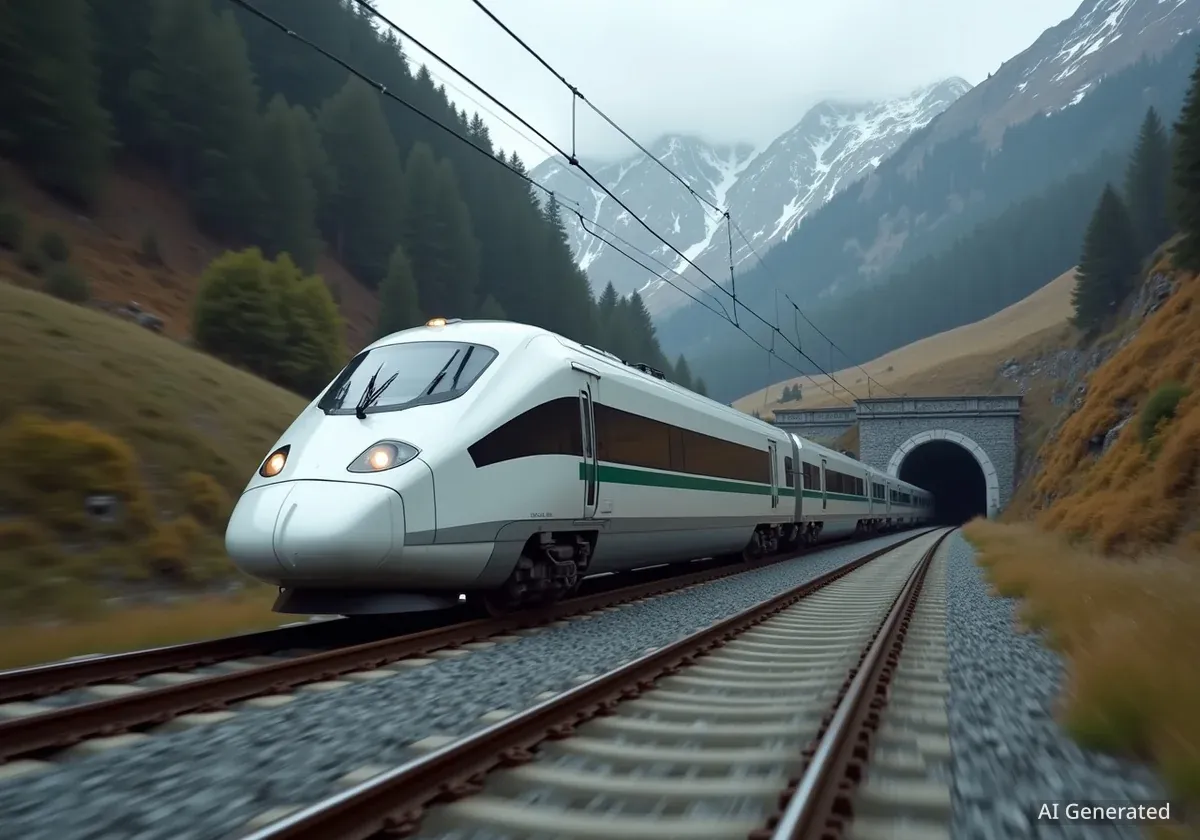Political and business leaders from Western Switzerland are calling for urgent investment to strengthen the East-West axis of the Swiss Federal Railways (SBB) network. They fear critical projects will not be completed if action is delayed. This push highlights a concern that the East-West connection, which serves a large portion of the Swiss population, remains underdeveloped compared to the heavily funded North-South routes.
Key Takeaways
- West Swiss leaders demand greater focus on the SBB East-West rail axis.
- Concerns exist that vital projects might face cancellation or significant delays.
- The East-West line connects nearly 80% of Switzerland's population.
- Billions have been invested in North-South routes, creating an imbalance.
- Delaying improvements could impact the country's main economic artery until 2050.
Call for Balanced Investment in National Rail Network
On Thursday, a group of several dozen politicians and business representatives gathered in Bern. Their primary message focused on the need to prioritize the East-West rail connections. They voiced significant apprehension that crucial infrastructure projects for this vital corridor might never be realized. This sentiment stems from a perception that the nation's railway policy has historically favored North-South routes.
Switzerland has invested billions of francs into its North-South rail links. These connections are important for transit through the Alps. However, representatives from French-speaking Switzerland, known as Romandie, argue that the East-West axis has been neglected. They describe it as the 'stepchild' of railway planning.
"The line from St. Gallen, through Basel, to Geneva connects almost 80 percent of the population to the rail network. We cannot afford further delays here," stated one of the transportation directors from a West Swiss canton at the press conference in Bern. "Otherwise, we risk the country's most important lifeline not seeing significant improvement until around 2050."
Rail Network Facts
- The Swiss Federal Railways (SBB) network spans over 3,000 kilometers.
- It carries approximately 1.32 million passengers daily.
- Switzerland has one of the densest rail networks in the world.
- Investment in rail infrastructure is a continuous national priority.
Economic Importance of the East-West Corridor
The East-West rail axis is more than just a transportation route. It acts as a critical economic artery for the entire country. This corridor links major economic centers from St. Gallen in the east, through Basel, to Geneva in the west. It facilitates trade, commerce, and daily commutes for millions of people.
A strong and efficient East-West connection is essential for regional development. It supports businesses and connects workers to job opportunities. Delays in upgrading this line could hinder economic growth across a significant portion of Switzerland.
The current infrastructure, while functional, faces increasing demands. Passenger numbers continue to rise, and freight transport needs efficient routes. Modernization is necessary to maintain Switzerland's reputation for excellent public transport.
North-South vs. East-West
Historically, Switzerland has prioritized cross-Alpine routes. Projects like the Gotthard Base Tunnel have dramatically improved North-South connections. These tunnels are engineering marvels and crucial for European freight and passenger traffic. However, this focus has led to concerns about underinvestment in domestic East-West links, which are vital for internal cohesion and economic activity.
Potential Consequences of Continued Delays
The West Swiss representatives warned of severe consequences if the necessary upgrades are postponed. They explicitly mentioned the risk of significant strengthening not happening until 2050. This timeline is considered unacceptable by many. It implies decades of potential bottlenecks and reduced efficiency.
Longer travel times and less reliable services could impact daily life for commuters. Businesses might face higher logistics costs. The overall competitiveness of Swiss regions along this axis could decrease. The rail network's capacity might also become strained, leading to overcrowding and service disruptions.
Furthermore, the lack of investment could lead to a two-speed railway system. One part of the country would benefit from modern, high-capacity lines, while another would struggle with outdated infrastructure. This could create regional disparities that impact social and economic equality.
Specific Project Concerns and Future Outlook
While specific projects were not detailed in the press conference, the general sentiment pointed to a need for increased capacity, faster connections, and improved reliability. These improvements would benefit both passenger and freight transport. The calls for action are not new, but the renewed emphasis from a broad coalition of leaders underscores the urgency.
According to the Swiss Federal Office of Transport, long-term planning for rail infrastructure is complex. It involves multiple stakeholders and significant financial commitments. However, the West Swiss cantons are pushing for these plans to be accelerated and properly funded.
The Swiss government will need to address these concerns to ensure a balanced and sustainable development of its national railway network. The coming months will likely see further discussions and proposals on how to best integrate the East-West axis into future investment strategies.
- Increased capacity: More trains and passengers can be accommodated.
- Faster connections: Reduced travel times between major cities.
- Improved reliability: Fewer delays and more punctual services.
- Economic stimulus: Support for businesses and regional development.
The push by West Swiss leaders highlights a critical juncture for national infrastructure policy. Balancing the needs of all regions is paramount for Switzerland's continued prosperity and connectivity.




